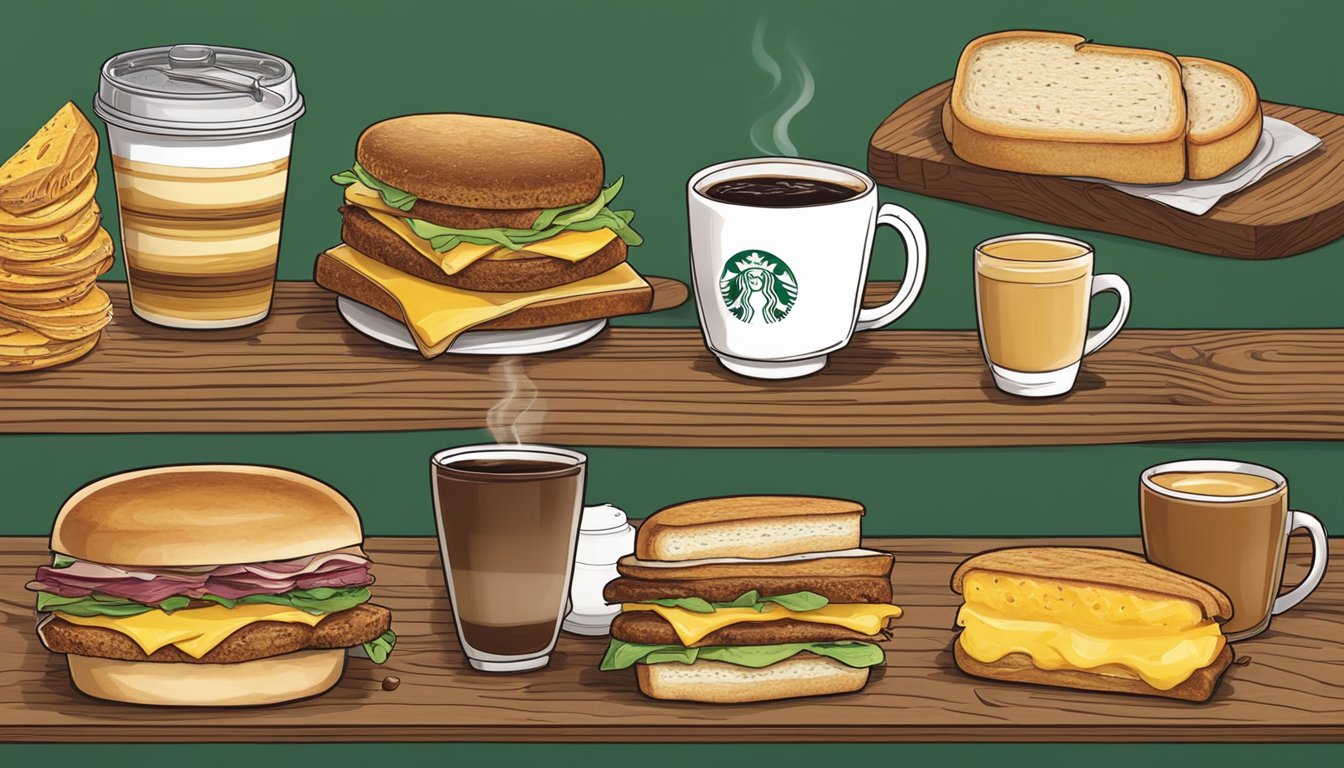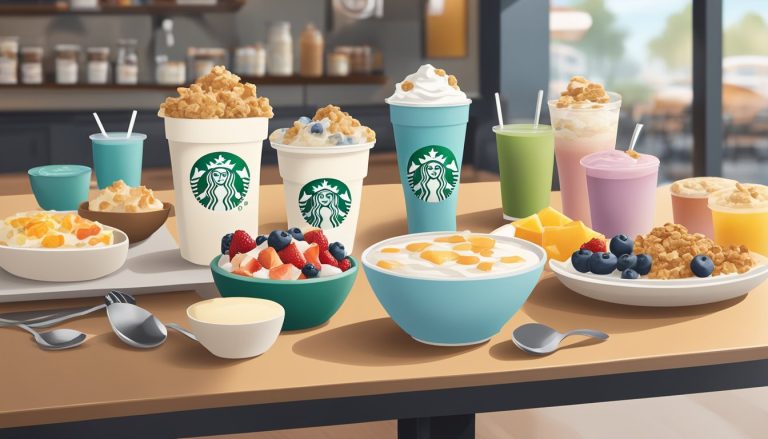Starbucks, the global coffee giant, has come a long way since its humble beginnings as a small Seattle coffee shop. Over the years, the company has expanded its menu far beyond just coffee, with breakfast sandwiches becoming a popular staple for many customers.
Starbucks first introduced food items to its menu in 1987, initially offering only pastries and baked goods from local suppliers. As the company grew, so did its breakfast offerings. Today, Starbucks boasts a diverse array of breakfast sandwiches catering to various tastes and dietary preferences.
From classic bacon, egg, and cheese combinations to plant-based options featuring Impossible™ sausage, Starbucks’ breakfast sandwich lineup has evolved to meet changing consumer demands. These convenient, on-the-go breakfast options have become an integral part of many customers’ morning routines, combining the comfort of familiar flavors with the efficiency of grab-and-go dining.
History of Starbucks Breakfast Offerings

Starbucks’ journey into breakfast offerings reflects the company’s growth from a coffee-focused chain to a full-service food and beverage destination. The evolution spans decades, encompassing strategic acquisitions and menu innovations to meet changing consumer tastes.
Founding Philosophy and Early Beginnings
In its early years, Starbucks primarily focused on coffee and tea. The company’s initial reluctance to offer food stemmed from founder Howard Schultz’s vision of recreating the Italian coffeehouse experience. This philosophy emphasized the aroma and taste of coffee without food distractions.
By the late 1990s, Starbucks began experimenting with limited food options. These included pastries and baked goods that complemented their coffee offerings. The introduction of these items marked a subtle shift in the company’s approach to food service.
Integration of La Boulange and Menu Expansion
Starbucks made a significant move in 2012 by acquiring La Boulange, a San Francisco-based bakery chain. This $100 million purchase aimed to elevate Starbucks’ food offerings. La Boulange’s influence led to a complete overhaul of Starbucks’ food menu.
The integration brought higher-quality ingredients and artisanal baking techniques to Starbucks stores. New items included croissants, loaf cakes, and an expanded range of breakfast sandwiches. This move helped Starbucks compete more effectively in the breakfast market.
Evolving Consumer Preferences and Menu Adaptations
As consumer preferences shifted towards healthier options, Starbucks adapted its breakfast menu. The company introduced items like protein boxes, egg white wraps, and oatmeal. These additions catered to health-conscious customers seeking nutritious breakfast choices.
Starbucks also embraced dietary trends by offering gluten-free and plant-based options. The introduction of the Impossible™ Breakfast Sandwich in 2020 reflected the growing demand for meat alternatives. The company continues to innovate, balancing traditional favorites with new, health-focused items to meet diverse customer needs.
Analysis of Starbucks’ Breakfast Menu

Starbucks has transformed its breakfast offerings over the years, expanding from simple pastries to a diverse menu of hot and cold options. The company has focused on quality ingredients and innovative recipes to cater to changing customer preferences.
Traditional Breakfast Favorites
Starbucks’ initial breakfast menu centered on bakery items like muffins, scones, and pastries. These classic choices complemented their coffee offerings and provided quick, grab-and-go options for busy customers.
The bakery selection expanded to include bagels, croissants, and danish pastries. Starbucks sourced high-quality ingredients to maintain consistency across locations.
Yogurt parfaits and fruit cups were added as healthier alternatives. These items appealed to health-conscious consumers seeking nutritious breakfast options.
Introduction of Hot Breakfasts
In 2003, Starbucks began testing hot breakfast sandwiches, marking a significant shift in their menu strategy. The initial offering was a simple egg and cheese sandwich.
By 2006, the hot breakfast lineup expanded to include:
- Bacon and ham sandwiches
- English muffin sandwiches
- Slow-roasted ham and Swiss cheese options
These additions allowed Starbucks to compete more directly with fast-food chains in the breakfast market. The hot sandwiches provided heartier meal options for customers seeking a more substantial breakfast.
Innovations in the Menu: Sous Vide Egg Bites and Beyond
Starbucks continued to innovate its breakfast menu with the introduction of Sous Vide Egg Bites in 2017. These protein-rich, low-carb options quickly gained popularity among health-conscious consumers.
The company also expanded its vegetarian and vegan breakfast offerings. Plant-based milk alternatives and meatless sandwich options were added to cater to diverse dietary preferences.
Recent additions to the breakfast menu include:
- Protein boxes with eggs, cheese, and fruit
- Overnight oats
- Avocado spread for customizing sandwiches
Starbucks has focused on using high-quality, responsibly sourced ingredients in its breakfast items. The company continues to adapt its menu to meet evolving customer tastes and nutritional concerns.
Starbucks’ Breakfast Food Ingredients and Nutrition

Starbucks has made significant changes to its breakfast menu ingredients and nutritional offerings in recent years. The company has focused on providing healthier options and increasing transparency about nutritional content.
Healthier Ingredients and Nutritional Transparency
Starbucks has eliminated artificial ingredients from many of its breakfast items. The company removed high fructose corn syrup, artificial dyes, and artificial flavoring from its food portfolio. This shift aims to provide customers with cleaner, more natural options.
Nutritional information is now readily available for all Starbucks menu items. Calorie counts are displayed prominently, helping customers make informed choices. Many breakfast options are under 500 calories, catering to health-conscious consumers.
Cage-free eggs are used in Starbucks’ breakfast sandwiches and egg bites. This change reflects the company’s commitment to ethical sourcing and animal welfare.
Plant-Based Options and Dietary Trends
Starbucks has expanded its plant-based breakfast offerings to meet growing demand. The company introduced plant-based sausage as an alternative protein option in select markets. This addition caters to vegetarian and flexitarian customers.
Dairy-free milk alternatives are available for customizing breakfast beverages. Soy, almond, and oat milk can be substituted in coffee drinks and smoothies. Gluten-free options have also been added to accommodate various dietary needs.
Protein-rich choices like Greek yogurt parfaits provide balanced nutrition for on-the-go customers. These items offer a mix of carbohydrates and protein to fuel the morning.
Business Impact of Breakfast Items at Starbucks

Starbucks’ introduction of breakfast items has significantly affected its financial performance and market position. The expansion into food offerings has driven revenue growth and strengthened customer loyalty.
Revenue Growth from Breakfast Offerings
Starbucks has seen substantial revenue increases from its breakfast items. Food sales accounted for 22% of total revenue in fiscal year 2020, up from 16% in 2013. This growth can be attributed to popular items like breakfast sandwiches, bakery goods, and Bistro Boxes.
The company’s decision to serve breakfast all day has been a key driver of success. This move allowed Starbucks to capture sales throughout the day, not just during traditional breakfast hours.
Breakfast sandwiches, in particular, have become a star product for Starbucks. They contribute significantly to the food category’s strong sales growth, driven by consumer demand for convenient meal options alongside coffee purchases.
Customer Retention and Competitive Positioning
Expanding breakfast offerings has improved Starbucks’ ability to retain customers and compete effectively in the coffee chain market. By providing a wider range of food options, Starbucks has given customers more reasons to visit and stay longer.
This strategy has helped Starbucks differentiate itself from competitors who may focus primarily on beverages. The combination of high-quality coffee and an expanded food menu has strengthened Starbucks’ position as a premium coffeehouse experience.
However, Starbucks has faced challenges in maintaining food quality perceptions. Some customers have expressed concerns about the taste or freshness of certain breakfast items. The company continues to refine its offerings to address these issues and maintain its competitive edge.
Customer Experience and Service

Starbucks has refined its breakfast service to enhance the customer experience during morning hours. The company emphasizes efficient operations, skilled baristas, and a welcoming atmosphere to position itself as a top breakfast destination.
Role of Baristas in Breakfast Service
Baristas play a crucial role in Starbucks’ breakfast service. They are trained to handle the complexities of morning rush orders efficiently. Baristas multitask between preparing coffee drinks and serving breakfast items.
Their expertise extends to recommending pairings of breakfast sandwiches with specific coffee blends. This personalized touch enhances customer satisfaction and encourages repeat visits.
Baristas also maintain cleanliness and organization during peak breakfast hours. Their friendly demeanor and quick service contribute significantly to the positive morning experience at Starbucks.
Operational Excellence in the Morning Rush
Starbucks has implemented several strategies to optimize operations during busy breakfast hours. The company introduced batch cooking for breakfast sandwiches, reducing individual warming times from 65-85 seconds to mere moments.
A heated rack or warming wall keeps pre-cooked sandwiches at optimal temperature. This innovation has dramatically decreased customer wait times during the morning rush.
Starbucks has also streamlined its ordering process. Mobile ordering and payment options allow customers to skip lines, further reducing congestion during peak hours.
The company continuously analyzes customer flow and adjusts staffing accordingly to maintain service quality during breakfast hours.
Starbucks as a Breakfast Destination
Starbucks has successfully positioned itself as a go-to breakfast destination. The company has expanded its breakfast menu beyond coffee, offering a variety of sandwiches, pastries, and healthy options.
Sales of Starbucks breakfast sandwiches have more than doubled over a four-year period. This growth indicates the success of the company’s breakfast strategy.
Starbucks creates a comfortable environment for morning customers. Cozy seating arrangements and free Wi-Fi make it an attractive spot for both quick bites and leisurely breakfasts.
The company’s rewards program, including personalized email offers, has boosted customer engagement. These targeted promotions have significantly increased response rates for breakfast items.
Marketing Strategies for Breakfast Products
Starbucks employs targeted marketing strategies to promote its breakfast offerings. The company focuses on seasonal promotions and holiday-themed items to drive sales. Advertising campaigns and public relations efforts play a crucial role in attracting customers to their breakfast menu.
Seasonal Promotions and the Holiday Menu
Starbucks leverages seasonal promotions to boost breakfast sales. The company introduces limited-time offerings tied to holidays and seasons. For example, the Pumpkin Spice Latte becomes a fall staple, often paired with seasonal breakfast items.
During winter, Starbucks rolls out holiday-themed breakfast sandwiches and pastries. These items complement their popular holiday drink menu. The scarcity of these seasonal products creates excitement and urgency among customers.
Starbucks also runs promotions like “Breakfast Happy Hour” during slower periods. These deals encourage customers to try new breakfast items at discounted prices.
Advertising Campaigns and Public Relations
Starbucks uses multi-channel advertising to promote its breakfast menu. Television commercials showcase new breakfast sandwiches and highlight their quality ingredients. Social media campaigns feature appetizing photos of breakfast items paired with coffee.
The company partners with influencers to reach younger demographics. These collaborations often focus on promoting healthier breakfast options or plant-based alternatives. Starbucks also leverages its mobile app to send personalized breakfast promotions to users.
Press releases announce the launch of new breakfast items. Starbucks invites food critics and bloggers to sample new offerings, generating buzz and reviews. The company emphasizes its commitment to sustainability in breakfast packaging, appealing to environmentally conscious consumers.
Looking Forward: The Future of Breakfast at Starbucks

Starbucks continues to innovate its breakfast menu, focusing on convenience, health, and flavor. The company aims to meet evolving customer preferences while maintaining its position as a leader in the fast-casual breakfast market.
Upcoming Trends and Customer Desires
Health-conscious options are gaining traction among Starbucks customers. Protein-rich, low-carb, and plant-based breakfast items are likely to become more prominent on the menu.
Customization is another key trend. Starbucks may introduce more mix-and-match options for breakfast sandwiches, allowing customers to choose their preferred bread, protein, and toppings.
Convenience remains crucial. The company might expand its grab-and-go breakfast offerings, catering to busy professionals and commuters.
Sustainability is increasingly important to consumers. Starbucks could incorporate more locally-sourced ingredients and eco-friendly packaging for its breakfast items.
Potential New Breakfast Launches
Starbucks may introduce a line of breakfast bowls, combining whole grains, vegetables, and lean proteins. These could appeal to health-conscious customers seeking a hearty morning meal.
Plant-based options are likely to expand. New vegan breakfast sandwiches featuring innovative meat alternatives could join the menu.
Seasonal and limited-time offerings may become more frequent. This strategy can create buzz and drive customer interest in trying new breakfast items.
International flavors might make their way into Starbucks’ breakfast menu. Fusion sandwiches combining global ingredients could attract adventurous eaters.
Portable, handheld options beyond traditional sandwiches may emerge. Breakfast wraps or savory pastries could provide variety for on-the-go customers.




